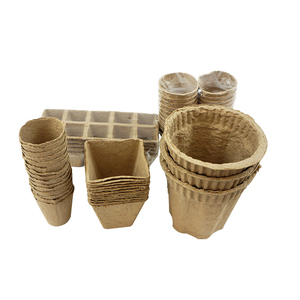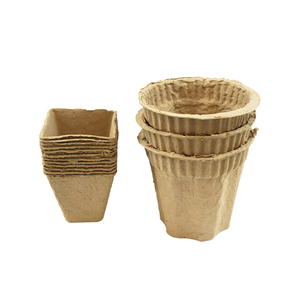(2821 products available)




























































































































































































































Biodegradable plant trays are eco-friendly alternatives to traditional plastic seedling trays. These trays are designed to hold seedlings and plants in nurseries and gardens. Unlike regular plant trays that can take hundreds of years to decompose, biodegradable trays break down naturally much faster when disposed of, reducing environmental impact and pollution. They are made from materials like sugar cane pulp, bamboo, and other biodegradable substances. They are perfect for anyone who wants to lessen their impact on the environment.
Biodegradable plant trays provide a natural alternative to plastic containers for growing plants. These trays are made to decompose naturally, thus providing a sustainable option for the cultivation of plants. Various biodegradable materials, such as bamboo, recycled paper, and bioplastics, are utilized to craft these trays. They are designed to support nurseries, gardeners, and researchers in their endeavors within ecological gardening or farming practices.
The biodegradable plant trays are made from various materials, each with unique benefits. Some are crafted from biodegradable plastics, while others use paper pulp or natural fibers like bamboo and jute. The trays are designed to break down in composting facilities or through natural processes, thus offering an eco-friendly solution for plant propagation. Here are the types:
Bioplastic Plant Trays
These trays are made from bioplastics, such as polylactic acid (PLA) and polyhydroxyalkanoates (PHA). These materials are derived from renewable sources like cornstarch and canola oil. Bioplastic plant trays are popular due to their lightweight nature and strength. They decompose in industrial composting facilities within a few months.
Pulp Trays
Paper pulp trays are another biodegradable plant tray. They are made from recycled paper pulp and designed to hold seedlings until they are transplanted into gardens or farms. These trays decompose quickly when buried in soil or placed in compost bins, making them suitable for one-time use. They are also less likely to harm wildlife if accidentally released into natural habitats.
Wood Fiber Trays
Wood fiber trays are crafted from wood fibers using a process that binds the fibers together with adhesives. These trays are sturdy and can hold heavy plants without breaking. They break down like pulp trays, so they're also good for the environment. These trays are often used by growers who want a strong yet biodegradable option for their plant containers.
Bamboo Trays
Bamboo trays utilize the fast-growing bamboo plant, known for its strength and resilience. Bamboo plant trays are reusable and have a long life span. They provide a more sustainable option than plastic trays. They biodegrade when disposed of, making them a good choice for environmentally conscious nurseries and gardens. Bamboo trays are also resistant to mold and pests, which can be an advantage in certain growing conditions.
Modular Trays:
Modular trays are plant trays that are designed to accommodate a variety of different plants. They are usually made of strong materials that can sustain the weight of big plants and are intended for long-term usage. Modular trays can be reused, but they are not biodegradable; thus, people throw them away after use.
Single Cell Trays:
Single-cell trays are plant trays with only one cell. They are widely used for starting seeds because they are inexpensive and easy to use. Single-cell trays are composed of plastic and are not biodegradable. People can throw them away after use.
Biodegradable Trays:
These plant trays are designed to break down into natural substances when disposed of, reducing their environmental impact. They are typically made from materials like bioplastics, which can decompose through microbial action, and other compostable substances. This design is crucial for reducing plastic waste in landfills and promoting a circular economy where products are returned to nature safely.
Recyclable Trays:
Recyclable trays are plant trays that can be recycled after use. They are usually made of strong plastic materials that can withstand multiple recycling processes. Recyclable trays are not biodegradable, so they need to be returned to the manufacturer for recycling rather than thrown away.
Nursery and horticulture industry:
Biodegradable seed starting trays are popular in the nursery and horticulture industry. These trays offer a reliable and eco-friendly option for nurseries to grow a wide range of plants. From flowers to vegetables and shrubs, these trays support plant health and development. They are particularly useful for large-scale operations that need to manage many seedlings. Using biodegradable trays, nurseries can ensure that their plant starting processes are aligned with sustainability goals.
Retail garden centers:
Retail garden centers can use biodegradable plant trays to display seedlings and young plants. These trays offer an appealing and environmentally responsible way for customers to buy plants. They support the growing demand for eco-friendly products. Moreover, these trays reduce the environmental impact of choosing and transplanting plants.
Vegetable and urban farming:
With the rise of urban farming, biodegradable plant trays have become a key tool for city dwellers and small-scale farmers. These trays make it easy to start vegetables indoors or in limited spaces before transferring them to larger gardens or outdoor plots. They are perfect for people who want to grow their food sustainably without harming the environment.
Educational institutions and community gardens:
Educational institutions and community gardens also use biodegradable plant trays. These trays support learning about gardening and environmental care. They are also used in workshops where people learn about the benefits of using biodegradable materials. This helps to raise awareness about the need to protect the environment.
Restoration and conservation projects:
Conservation projects that focus on restoring native plants use biodegradable plant trays to grow these plants. These projects prioritize using local species to restore ecosystems and support biodiversity. Using biodegradable trays in such projects reduces the risk of pollution and supports the natural environment.
Choosing the right biodegradable plant trays is crucial for ensuring sustainable plant propagation and alignment with environmental goals. Here are some key factors to consider when selecting biodegradable plant trays:
Material composition:
Biodegradable plant trays are made from various materials, each with its advantages and limitations. Choose trays made from plant-based materials like PLA, PHA, or PBAT for sustainable options. Consider materials such as bagasse, bamboo, or wood fiber for their biodegradability and strength. Evaluate the material composition based on factors like biodegradability, compostability, and potential for reducing plastic waste.
Tray biodegradability:
Check if the plant trays will break down naturally over time, either in a composting facility or in the natural environment, reducing their impact on landfills. Look for trays that meet relevant biodegradability standards, such as ASTM D6400 or EN 13432, which specify the criteria for materials to be considered biodegradable in composting or natural conditions. Choosing trays that will naturally decompose reduces the risk of plastic pollution and supports a circular economy.
Propagation stage:
Select biodegradable plant trays suitable for the specific stage of plant growth and propagation being used. For early seedling development, choose trays with shallow cells and fine cell structures to accommodate small seeds and young seedlings' delicate root systems. For larger plants, select trays with deeper cells and robust designs to support root expansion and minimize transplant shock. Matching the tray design to the propagation stage ensures plants are healthy and reduces the risk of damage during transplantation.
Compatibility with planting methods:
Consider how the biodegradable plant trays will be transplanted into the final planting locations. Select trays that minimize root disturbance and transplant shock, which can hinder plant growth. Look for biodegradable trays designed to be gently removed from the tray during planting, such as those with porous or easily detachable cell structures. Choosing trays compatible with planting methods reduces stress on transplanted plants and promotes faster establishment in their new environment.
Performance and durability:
Evaluate the performance and durability of biodegradable plant trays, considering factors like their strength, resistance to moisture, and ability to handle handling and transportation. Ensure that the trays can withstand the demands of the nursery or greenhouse environment and maintain their integrity until the plants are ready to be transplanted. Choosing durable trays reduces breakage and plant loss, ensuring reliable performance while minimizing environmental impact.
Q1. What are the benefits of using biodegradable plant trays for growing plants?
A1. Using these plant trays can improve soil health, reduce plastic waste, support sustainable farming, and comply with environmental regulations.
Q2. Do biodegradable plant trays break down in all types of soils?
A2. They biodegrade more quickly in sandy soils and soils with a lot of organic matter and compost.
Q3. Can biodegradable plant trays be used for all types of plants?
A3. Biodegradable plant trays are suitable for many plants, but it's essential to consider each plant's specific requirements.
Q4. How can people ensure that the plant trays decompose as intended?
A4. Users should dispose of the trays correctly, either through composting facilities or in home compost bins, to ensure they break down as intended.
Q5. Are biodegradable plant trays as durable as plastic trays?
A5. They may have different strength and durability characteristics, so choosing the right tray for the specific application is important.